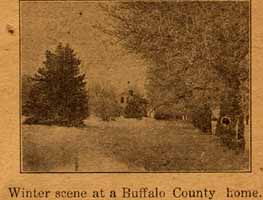
|
This little booklet is now very fragile and the pages are darkened
with age. The pages are not numbered, and about half the booklet is ads.
This reproduction maintains the original page breaks,
and I have added an index for the display ads.
Index to Display Advertisements
Alphabetical List of Veterans of the
Civil War and Spanish American War.
This book is part of the Mardos Memorial Library of Pam Rietsch.
Thanks, Pam!
|
To the People of Buffalo county Greetings: |
We give you this little book free of charge. We have tried herein to give you something that you will prize and want to keep. We do not call this book the work of art. It is plain, but at the same time we believe you will find some very good reading in it. We believe you will like it and show it to your friends. |
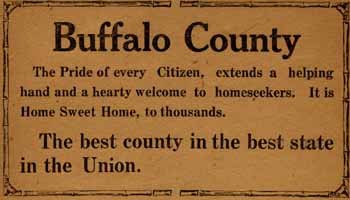
We feel wholly unworthy to put on paper the beauty and wonderful advantages of Buffalo county and like-wise the good-fellow-ship and prosperity of her citizens. We know we cannot do the county or her citizens justice. We know that we cannot begin to tell you how proud we are to be living within the hospitable gates of the best county in the state, but you, who are enjoying the privelidge [sic] will understand and know and those who are not so fortunate as to be a citizen of our county will have to make it a visit and see for themselves in order to fully appreciate what we have already said and are about to say:-- |
Kearney, the county seat, is the largest city of the county. It had a population of 6,200 in 1910. Buffalo county has no waste lands The diversity of the soil to suit the most fastidious. A very large acre- age borders the Platte, Loup and Wood rivers, is the richest in the world.
The farmers produce alfalfa, wheat, corn, barley, rye, sugar-beets, potatoes, sweet corn, tomatoes, and other canning crops, broom corn, seeds, sorghum, cane, celery, and many other crops. The rainfall for the past ten years ending January 1912, was 27.06 annually, most of it during the growing season, when it is most needed. This county has a population of 21,900.
Bees, poultry and dairying yields a golden harvest, with a small expense in connection with the large acerage [sic] of alfalfa. In fact, is one |
of the leading counties in dairying and poultry in the state, which is growing in popularity. There will be 200,000 head of sheep fed in Buffalo county this year, or 20 per cent more than any other year. Elmcreek has 620 people, Ravenna
1,359, Gibbon 718, Amherst 256, Shelton 1,000, Miller 400, Kearney 6,202.
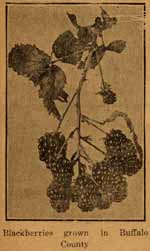 Blackberries grown in Buffalo County First let us dwell upon our county seat town, Kearney. Kearney, the city beautiful, with her fine large business and dwelling houses, with her paved streets and boule vards, with her beautiful parks and the popular pleasure resort, Lake Kearney. |
Kearney with her 9000 people-- the biggest little city in the world in more than one sence [sic] of the word--big in her business life,
big in her moral environments and BIG IN HER LOYALTY TO HOME INTERESTS. |
among other articles manufactured for outside trade are:--Harnesses, saddles, chicken feeders, blank books, cigars, soft drinks, butter ice cream monuments and rugs. Kearney is also an important grain market.
Much could be said in favor of the worthy organization and its beautiful club rooms. The members are all congenial, big-hearted men, who meet regularly and discuss and plan for the betterment of Kearney and Buffalo county. But they do not stop with that, they "pull together," they find something to do and then get out and do it. 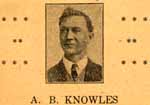 A. B. KNOWLES Formerly Instructor in the Carpentering Department of the Industrial School at Kearney. Now engaged in his trade at Miller. | 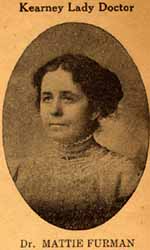 Dr. MATTIE FURMAN Osteopathy Osteopathy has made greater strides than any other system of the healing art in the same length of time, not because the others systems are valueless, but because Osteopathy offers more. |
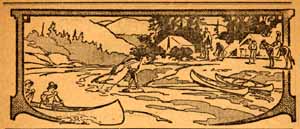
will now recite. |
which was killed on the townsite, about where the Midway hotel now stands.
Recently while reviewing her pioneer experience, she said:
|
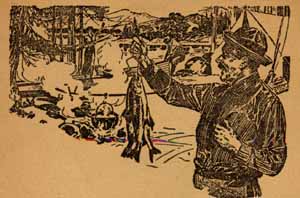
Scarcely less interesting than the buffalo horns is a hair lariat which Mrs. Collins still has in her possession. A smoothly braided piece of handicraft, it was wrought of buffalo hair by a Pawnee Indian. The line, with its buckskin loop, is some twelve feet long. Three of such ropes the native was offering for sale when he came to her house for something to eat, and he was very particular that she should have the best of the lariats.
|
the peeping natives a long look and ordered them away. As they went they looked back over their shoulders, each of them broadly grinning. I knew they did such things merely for mischief like prankish boys.
|
time stored in our attic."
A Few Facts And Figures The 1915 census shows Buffalo county to have 1,128 farm owners living on their farms and 1,187 tenants. |
There are 590,544 acres of improved farm lands and 309,039 acres are under cultivation. The amount of improvements is $1,852,810. In 1916 Buffalo county produced 18,574 head of horses and mules with a total value of $1,867,145.00; 39,721 head of cattle, value $1,768,540; 20,853 head of cattle, value $1,768,540; 29,853 head of hogs, value $597,060; 27,283 head of sheep, value $190,981; and 13,965 doz. chickens. | |
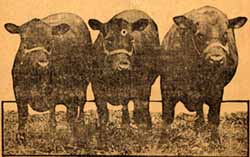
| ||
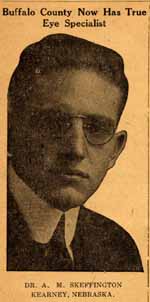 Dr. A. M. SKEFFINGTON KEARNEY, NEBRASKA.
Buffalo county and the surrounding country can feel themselves fortunate in having gained as a resident Dr. Skeffington. |
Smile, of course -- it costs nothing. | |||||||||||||||||
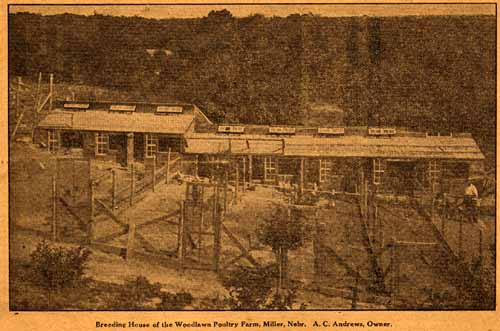
Breeding House of the Woodlawn Poultry Farm, Miller, Nebr. A. C. Andrews, Owner.
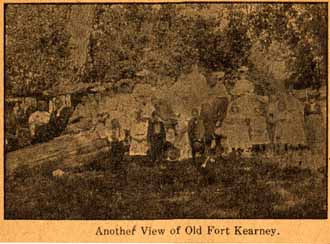 | ||
|
But sometime we hear some one say, There lives Mr. So and So A pioneer settler, don't you know. He came here when this land was wild And on a virgin homestead filed. Fifty years ago or more they say, He landed here and determined to say. He stayed here through thick and thin And helped to make this country win. When he came long years ago, No railroad trains passed to and fro, No wagon roads e'en then to travel He picked his way o'er hill and hollow |
There was nothing here on these prairies wild, When he on his virgin homestead filed. No telegraph or telephone, No parcels post rated by zone, No R. F. D. in pioneer day The post office then was miles away. Men like him with courage and will Opened the way for work shop and mill, Paved the way for prosperity's feet Never turned back or acknowledged defeat. Suffered privations and hardships severe Not only once but year after year. Lived through the season of hail, storm and drouth, | |
|
Ravage of hopper and hot winds from the south. Lived in sod houses or dugouts they say, Glad for a shelter built any old way. Like heros [sic] undaunted with spade and plow, They brought up this country to what it is now, An unbroken plain to a garden fair, Made it yield a plenty, enough and to spare. There [sic] lives and their efforts were not spent in vain, They built up good homes on this wild, western plain. Out of the rough they carved a great state, Not one in the U. S. any more great. They built fine churches and school houses, too. And many great things they managed to do. These men were brave heros, yes, heros we say, Who settled Nebraska in pioneer day. No less do we honor the women who came. Brave and true hearted maiden or dame Came with their husbands as mother or bride And through all the hardships stood by their side With very few comforts and luxuries none. Without them, their life mates could never have won. Brave heroines, no less were they, Brave heroines of pioneer day. Charlotte F. Stockdale Thompson, Hazard, Nebr. |
On the Kearney and Blackhills branch of the Union Pacific seventeen miles northwest of Kearney will be found the flourishing little town of Amherst. With a population of about 400, and surrounded by a rich and attractive agricultural territory, Amherst is enjoying a healthy business, and although with in reaching distance of the city of Kearney in this age of the automobile, people do not take advantage of same to do their trading in the city to any great extent, but patronize their home merchants and business men. This no doubt is the reason one finds large and up-to-the minute stocks of stocks of goods in the business houses of Amherst. |
ches are represented.
And I swan I'm right; He sez the dances they have today are better By far in every way Than the old square dances we uster know In the good old days of the long-ago. I sez to him, sez I, "By jing, now look here, Ezry, They ain't no sich thing. "You take the tango you dance today, You hop an' you skip, an' you jump an' away; You grab yer lady around the neck |
And you slam her nearly to death, by heck; I can't see, Ezry, how you kin feel That's better'n the old Virginia reel; They ain't no fun, and they ain't no grace, In grabbin' yer partner by the face, An swingin' her 'round 'till she's nearly drunk. You know, now, Ezry, that stuff's all buuk." But Ezry's headstrong, and he sez, "By Jing, I say the tango is jist the thing; The Virginia reel is too derned slow; Ya kin see a reel at a picture show; No use to argue atall," sez he, A figger'n he had jist sqelched me. "But," I allowed with much elation "Well, how about this here hesitation?" "Some waltz," sez he, "you know it. Still, I s'pose yer stuck on the old quadrille." "Well, 'Ezry," I sez, "you've struck it right. It's better'n that waltz, a gol derned sight. I'll take the good old time quadr'lle You kin hesitate 'til ya get yer fill." "There's life to the music they dance today," Wuz the next thing I heerd Ezry say. |
"Too much mustard's got the swing" Ex. Our "Man With the Hoe!" stalwart and strong he stands; As fine a man as ever was moulded by nature's hands. Now that he knows he can fill a much needed place, Not 'emptiness,' but a noble purpose glorifies his face, Thus with strength and will he shoulders the hoe To help feed his fellow brothers fighting the foe." Counterfeit Potatoes.
The expected has happened. Counterfeit potatoes are in circulation. They are taking their in place with phony greenbacks and paste diamonds and are said to be such a good imitation that it takes an expert to tell the differance [sic] between the real and the make-believe. |
|
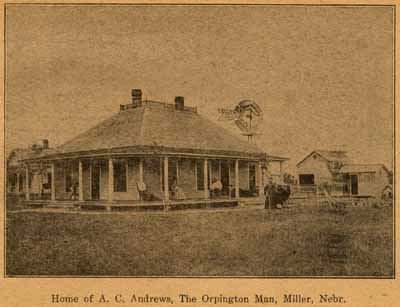
Home of A. C. Andrews, The Orpington Man, Miller, Nebr.
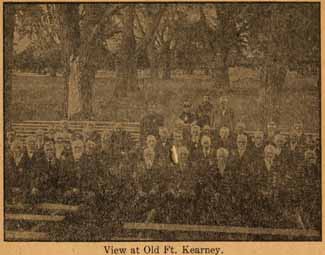
View at Old Ft. Kearney
ro Jenkins, Pleasanton; Vencil Kerel, Ravenna; H. W. Kenney, Kearney; Win. Keyser, Kearney; J. R. Larimer, Kearney; J. A. Larimer, Kearney; Simon Landis, Kearney; Jno. Lawler, Kearney; James Light, Shelton; J. H. Lyon, Kearney; A. Lawton, Kearney; Robert Lutch, Kearney; Robt. A. Mears, Shelton; John Michie, Ravenna; W. H. Marshall, Kearney; Robt. Mitchell, Elm Creek; Paul Miller, Ravenna: J. E. Miller, Kearney; John Mercer, Miller; J. S. McKean, Kearney; Daniel Morgan, Kearney; J. H. McCartney, Elm Creek: B. W. Mowery, Miller; James Newman, Ravenna; W. O. Pickett, Sweetwater: David Pickerell, Kearney; O.I. Prindle, Kearney; |
W. J. Perkins, Kearney; Levi Page, Kearney; C. G. Perking, No. 1, Pleasanton; Robt. Reynolds, Keariney; Fritz Rohrbach, Shelton; J. E. Strain, Kearney; John Swenson, Sartoria; O. B. Smith, Kearney; L. P. Southworth, Ravenna; J. M. Shultz, Shelton; D. Stonebarger, Shelton; F. A. Sibert, Miller; Rev. E. Smith, Kearney; J. W. Stevens, Kearney; Jno. M. Schneider, Kearney; C. H. Shrader, Ravenna; Henry Schmitz, Riverdale; J. S. Salsbury, Ravenna; L. Smith, Kearney; Ceo. Smith, Kearney; J. H. Snyder, No. 2 Kearney; F. J. Switz, Kearney; A. J. Snowden, Kearney; P. F. Smead, Kearney; T. W. Swinyer, Kearney; J. H. Tomb, Kearney; J. H. Tucker, |
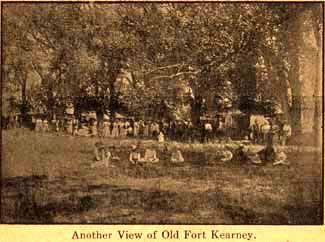
Another View of Old Fort Kearney
Kearney; A. E. Tracy, Kearney; Wm. Talbott, No. 5 Gibbon; E. Wyman, Gibbon; S. Watson, Gibbon; Jay Winslow, Kearney; S. T. Warren, Kearney; James Wilkie, Shelton; W. T, Woody, L. A. Weldin, Gibbon; P. B. Wensel, Shelton; J. A. Wilt, Kearney; M. A. Young, No. 1, Pool. E. W. Allen, Kearney; Frank Berber, Pleasanton; Henry F. Brown, Litchfield; Ed Bernert, No. 1, Riverdale; John L. Bronson, Amherst; E. J. Carson, Kearney; R. O. Day, Miller; Geo. Dill, Ravenna; T. H. Fowler, Ravenna; S. E. Grosh, Kearney; Dallas Henderson, No. 1, Kearney; M. A. Hoover, Kearney; Dr. H. N. Jones, Kearney; Venzens Kreutzer, Pleasanton; J. C. La Cornu, Kearney; G. W. Lawson, Shelton; |
G. W. Mueller, No. 5, Kearney; J. P. Morris, Kearney; F. C. Moore, Ravenna; D. Martindale, Kearney; C. H, Petty, Kearney; Clinton Pake, No. 1, Poole; T. A. Pickeral, Kearney; M. A. Prideaux, Elm Creek; E. Quillen, Ravenna; A. E. Soderquist, Kearney; Wm. Snowden, Kearney; A. M. Sharman, Kearney; P. J. Templeton, Ravenna; James Wadley, Gibbon; G. W. Wilson, No. 5. Kearney; Garfield Voiced Nation's Gratitude to Civil War Soldiers. |
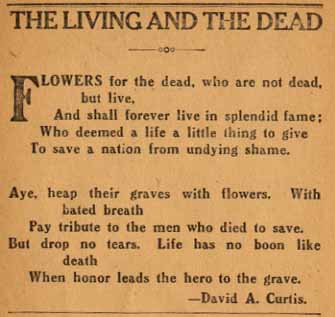
If each grave had a voice to
tell us what its silent tenant last saw
and heard on earth we might stand
with uncovered heads and hear the
whole story of the war. We should
hear that one perished when the first
great drops of the crimson shower began to fall, when the darkness of that
first disaster at Manassas fell like an
eclipse, on the nation; that another died
of disease while wearily waiting for
winter to end; that this one fell on the
field in sight of the spires of Richmond, little dreaming that the flag
must be carried through three more
years of blood. |
voices from the Wilderness and triumphant shouts from the Shenandoah,
from Petersburg and the Five Forks,
mingled with the wild acclaim of victory and the sweet chorus of returning
peace. The voices of these dead will
forever fill the land like holy benedictions. |
Next Page
Index of Display Ads |
Civil War and Spanish America War Veterans
Back to Buffalo County NEGenWeb Project
